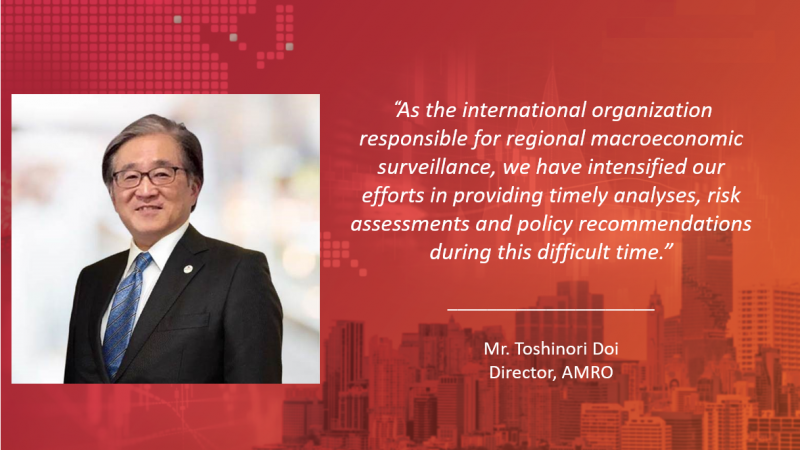
In the short space of time since my appointment as Director of the ASEAN+3 Macroeconomic Research Office (AMRO) in May 2019, I witnessed the world we live in thrown into disarray and transformed by an extraordinary crisis.
The COVID-19 pandemic might have changed the way we work, but it has not stopped us from zealously delivering on AMRO’s mandate. Over the past year, AMRO’s senior management team and I, with the support of every staff, have been steadfast in strengthening AMRO’s role as a capable “family doctor” and trusted policy advisor to our members.
COVID-19 in ASEAN+3
The COVID-19 pandemic will likely be the crisis of our generation.
Now in its ninth month, the outbreak has infected over 27 million people and caused more than 800,000 deaths.
The massive shock of the pandemic and the large-scale containment measures have plunged the global economy into the worst recession since the Great Depression.
In response to this health and economic crisis, the ASEAN+3 governments have taken decisive and strict measures to contain the virus, and in many cases, locked down entire countries. To support the economy, policymakers have rolled out unprecedented monetary and fiscal stimulus, as well as other measures.
Against this backdrop, AMRO has downgraded our projections for the region. Based on the forecast in August, we expect the ASEAN+3 region to register zero growth in 2020, a large shock compared to 4.8 percent growth last year[1].
Nine of the 14 ASEAN+3 economies are expected to contract in 2020. While China is leading the recovery, we forecast that its economy will only expand at 2.3 percent this year amid strong external headwinds. Meanwhile, Japan and Korea are expected to register negative growth; in Japan’s case, by 5.4 percent. The ASEAN region is estimated to shrink by 2.6 percent.
As the economies cautiously reopen and activity gradually resumes, we expect the region to pick up and expand by 6 percent in 2021, provided there are no sustained re-emergence of the pandemic requiring a second round of strict containment measures in the region—or in any of the other major economies for that matter.
Impact on the region’s growth miracle
The US-China trade tensions and this pandemic have disrupted the global and regional supply chains, in both goods and services.
Derived demand within the region has been significantly affected. While regional exports were hurt by the US-China trade conflict pre-pandemic, the external sector was supported partly by the demand for its services, particularly tourism. The pandemic has brought travel and tourism to a halt, and economies that heavily rely on this sector-are the hardest hit.
Despite the huge hit to growth, the ASEAN+3 economies remain fundamentally strong and resilient. Regional economies strengthened their governance, regulation, and supervision of financial and non-financial corporates, adopted more prudent macro-policy practices, and built up reserve and policy buffers in the wake of the 1997/98 Asian financial crisis and 2008/09 global financial crisis.
Consequently, they have been able to introduce fiscal support packages, ease monetary policy, and afford some regulatory forbearance to cushion their economies against the impact of the pandemic.
AMRO’s role as a “family doctor”
During these turbulent times, AMRO is more committed than ever to contribute to the economic and financial stability of the ASEAN+3 region.
As the international organization responsible for regional macroeconomic surveillance, we have intensified our efforts in providing timely analyses, risk assessments, and policy recommendations.
In ensuring that accurate information is shared with policy and decision makers in a timely manner, we continuously upgrade our corporate website, recently introduced a COVID in Focus microsite to feature our daily insights and leverage on digital channels to push out our content to other stakeholders.
One of AMRO’s core functions is to support the implementation of the Chiang Mai Initiative Multilateralisation (CMIM). Persisting global uncertainties and the region’s continuing integration with the global economy have highlighted the importance of the CMIM’s crisis prevention and resolution facilities, which stand at the center of the ASEAN+3 financial safety net. From this perspective, I am pleased that AMRO played a part in contributing to the second amendment to the CMIM agreement to enhance its operational readiness, which came into effect on June 23 this year.
AMRO’s mandate—to contribute to securing the macroeconomic and financial stability in the ASEAN+3 region—was made crystal clear from day one, and we are fully committed to performing the duty of a capable and trusted family doctor to members. We have revised AMRO’s medium-term work plan, putting forward our new priorities and initiatives, together with our goal of building a nimble, stronger, and more effective AMRO.
I would like to thank our member authorities for their unwavering support and look forward to working hand-in-hand with them to guide the ASEAN+3 region out of this crisis toward sustainable growth and opportunities in the new normal.
[1] As of publication, AMRO is in the midst of revising the economic projections for the region.
